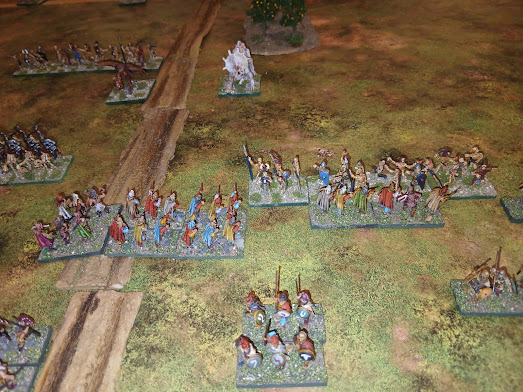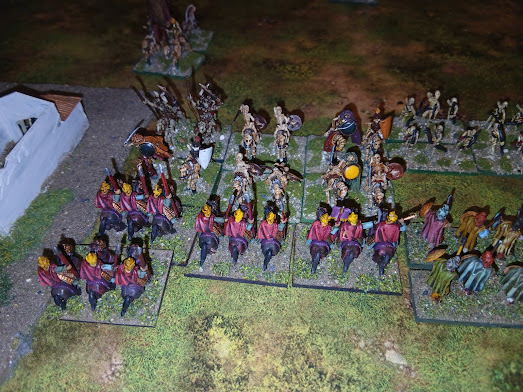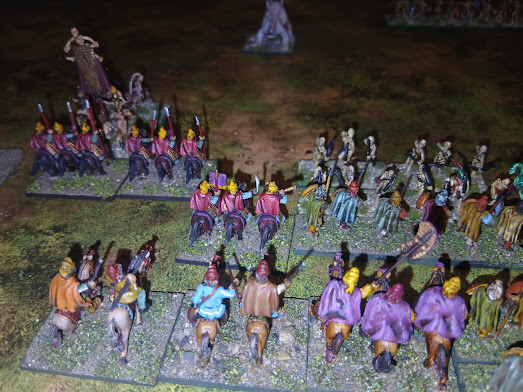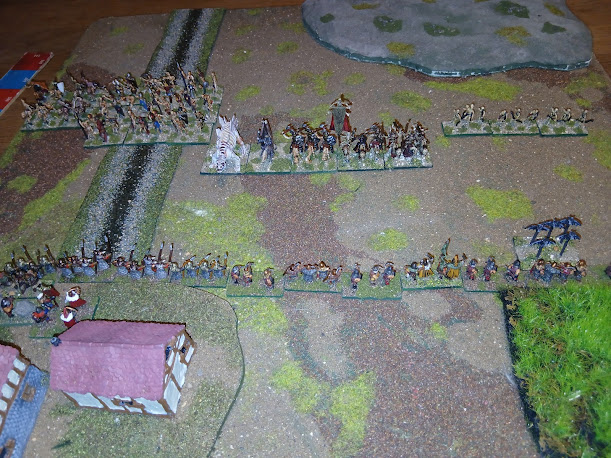Undead Vs Cappadocians DBF
I tried out DBF with a 200pt solo game today, using Undead Vs my Cappadocian army for Ancients.
Overall the rules worked well , having a more balanced feel at 200pts. I did make 1 or 2 mistakes with the rules, but that is the point of solo games, to raise questions that can be learned from.
The Undead were the attacker, so I used the Terrain table for the Cappadocians which I assumed to be Arable ( that is what is used for a lot of more civilized armies in the rules). There was a ruined built up area (BUA) on the human left flank, some swampy ground to the right, and a road running down the middle. There was also a field beyond the swamp, a small wood in the Undead deployment zone and some rough ground near the BUA, all of which had absolutely no effect on the battle. The BUA and swamp did narrow the battlefield , so the Undead couldn't bring their numerical advantage to bear.
Initial set up
Undead Behemoth and Hordes with Hero in a chariot a Mage General
Knights with General, Bow and a pair of Behemoth with some utterly useless Horde to the rear.
A flank command of entirely Light Mounted
Heavily armoured knights ready for combat
Each Cappadocian command had 6 Auxillia, 4 Bow & 2 warband
A hero leading 3 light mounted
Turn 1 for the Humans saw some very low Pip rolls, so a piecemeal advance but no combat.
The Undead likewise roll poorly and shamble forwards, but not very far..
Another set of poor rolls for Pips, except the Light Mounted command who surge forwards led by a Hero General in a snazzy purple cloak.
Side view as it Hero vs Hero & Light Mounted vs Light Mounted
The Human Hero destroys his bony opponent and his wingman to his left holds off greater numbers
The Undead Light mounted countercharge, with their Fear special rule causing the Human Hero & Light Mounted to flee ( not very heroic...)
There is some bowfire exchanged but missile fire isnt great against the Undead.
The Undead Commander closes with some Horde.
Auxillia & Bow facing Knights & Bow.
The Undead mage on foot is facing a mass of bow with Warband in support. The archers throw a 6.
He foolishly rolls a 1
The Knights get stuck in against the light Horse. Each result was a loss for the Knights by 1, but I thought their Heavy Armour saved them. This was a mistake, as that only kicks in when Doubled, not merely beaten, so the Undead should have turned that flank.
The Undead Knights advance against the Human bow but fall short of contact.
The Undead Fear rule sends an element of Auxillia fleeing.
A big boney Behemoth charges the Knights on the Human right flank.
He had a Hero to his right, but a bad roll saw him felled by the Knights.
More Auxillia heroically running away while one of their comrades destroys the horde in front of them.
Undead bowfire is ineffective against the Auxillia.
A disasterous run of low results sees the Undead Light Mounted destroyed, breaking that command.
Some big gaps opening in the Undead lines
The Undead Mage uses what few Pips they got to Resurect 2 Hordes as the Command nears Break Point.
The Knights charge home, driving the Mage back.
The Undead Knightscharge home, but the weight of numbers makes this a risky move.
Knights engage the remnant Light Mounted while Auxillia charge the Undead Bow
The Undead Knights each destroys an Infantry Element, so 2 Bow & 1 Auxilla bite the dust.
Human Bow destroys a Behemoth while the Resurected Hordes die again, leaving the mage very exposed.
This breaks the Undead army, but I played out the Undead turn.
The Knights make no progress and lose one of their number.
The last of the Hordes goes down.
A hail of arrows has no effect on the last throw of the game.
It was a fun game, but obviously it is harder try to play both sides of the game at once. The only real mistake I made ( that I am aware of so far) is the mix up with the Heavy Armour rule, that effect is from High Morale...
I did the Undead a disservice with a very poor army list. I was using what figures I had available, but the Hordes and Behemoths both need an extra Pip to move so having both in a command with a Mage who needs Pips to cast spells was a recipe for inactivity as well as disaster. At least 1 Behemoth and 4 of the 9 Undead Hordes never made it into combat, and the wizard on foot didnt get a spell off before being taken out by a hail of arrows. Both sides rolled quite poorly for Pips throughout the game, but this meant the Undead Mages underperformed terribly.
It was still a fun bash, and I finally got my Cappadocians on the table , with a victory for their first outting.
I will try another 200pt solo game soon, but not with Undead until I can get some better options painted up.
Phil
























































